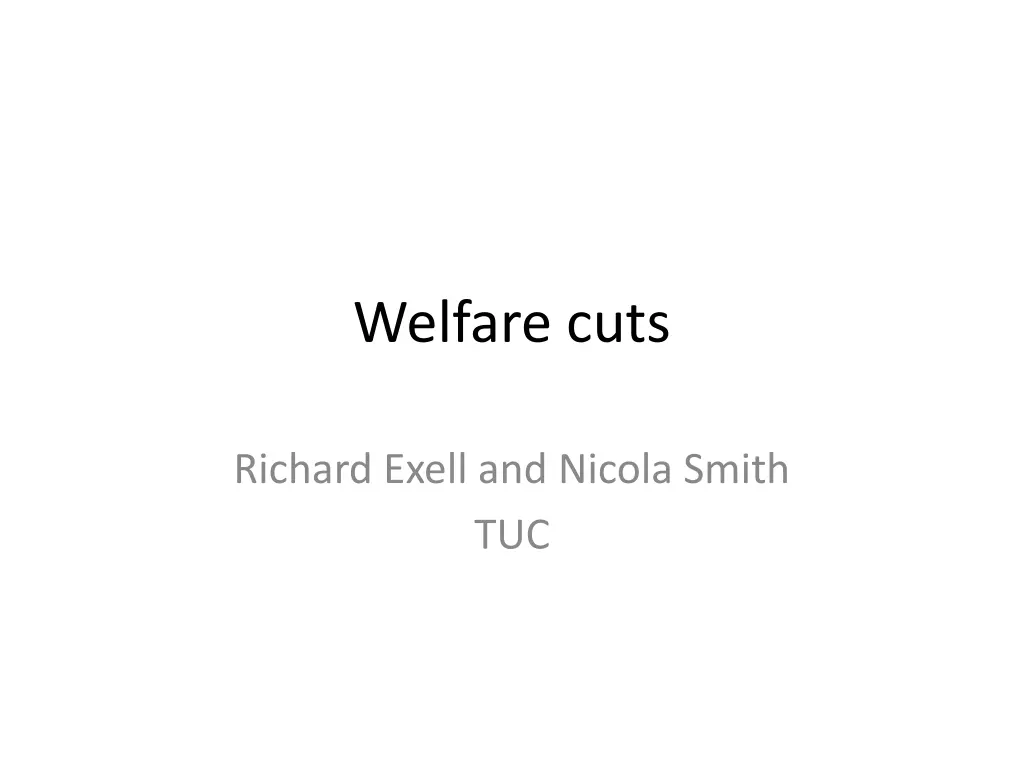
Understanding Welfare Cuts and Tax Credits for Families
Explore the impact of welfare cuts, tax credits, and changes affecting families in the UK. Learn where welfare spending goes, details of tax credit allocations, budget changes, and additional adjustments. Understand the implications for children, households, and working parents facing high childcare costs.
Uploaded on | 0 Views
Download Presentation

Please find below an Image/Link to download the presentation.
The content on the website is provided AS IS for your information and personal use only. It may not be sold, licensed, or shared on other websites without obtaining consent from the author. If you encounter any issues during the download, it is possible that the publisher has removed the file from their server.
You are allowed to download the files provided on this website for personal or commercial use, subject to the condition that they are used lawfully. All files are the property of their respective owners.
The content on the website is provided AS IS for your information and personal use only. It may not be sold, licensed, or shared on other websites without obtaining consent from the author.
E N D
Presentation Transcript
Welfare cuts Richard Exell and Nicola Smith TUC
Where is welfare spent? Child Benefit, Child Trust Fund and Health in Pregnancy Grant, 7% Other, 7% Council Tax Benefit, 2% Housing Benefit, 10% Tax Credits, 15% Income Support, 5% DLA, 6% Attendance Allowance, 3% Incapacity benefits, 4% State pension , 29% JSA , 2% Pension Credit, 4% SERPS and S2P, 7%
Tax Credits: current position for sample family Sample family: Couple household, one member working 30+ hours and one 16 hours, two children in childcare (one baby) Maximum award: around 19,000 (salary dependent) Working Tax Credit Basic element: 1,920 Couple element: 1,890 30 hour element: 790 Childcare: 12,480 Child Tax Credit Family element: 545 Child element: 4,600 Baby element: 545
Tax Credits: Budget and CSR changes (sample family - high childcare costs)
Lost awards by household (sample family - high childcare costs)
Tax Credits: additional changes Tax Credits for families Cancel introduction of supplement for toddlers (planned for 2012/13) Reduce income disregard to 5,000 from 2013/14 (presumption that real time information will overcome problem of over payment?) Reduce backdating to one month from 2012/13 ( real time system not scheduled until 2014/15) Increase working hours requirements from 16 hours to 24 hours for couple households (far from encouraging small amounts of work, this makes it harder for work to pay for low income couples and where do the savings come from?) Wider benefit changes for families Child Trust Fund abolition (including cuts for disabled children this year) Child Benefit freeze Child Benefit cut for households with a higher rate taxpayer Health in Pregnancy Grant abolition Sure Start Maternity Grant abolished for all but first child Lone parent conditionality for those with children aged 5 and above from October 2011
Households receiving Housing Benefit
Cumulative impact is key Budget Move to set Local Housing Allowance at 30th percentile of local rents and index to CPI Increase deductions for non-dependents Limit social sector entitlements to family size Cut entitlements by 10 per cent for those who have spent a year on JSA Cap maximum rates and maximum property size (4 bedrooms) Remove 15 excess payment CSR Benefit cap (to be administered by local authorities reducing Housing Benefit) Shared room rate to apply to those aged 25-34 (as well as to young people) Social rents to rise (who will pay for this Housing Benefit?) Council Tax Benefit to be cut by 10 per cent and localised requiring local authorities to collect outstanding CTB from their most vulnerable residents
Unintended losers? Working households who receive state help with Housing Benefit Hostels and refuges where incomes fall as a result of Housing Benefit cuts Homeless ex-offenders and those with severe mental health problems who cannot be accommodated in shared housing Young children who have to move schools Households who simply cannot find anywhere to live Households who can no longer afford to work
Already announced in the Budget Objective medical assessments for Disability Living Allowance This week s changes One-year time limit for people who receive contributory Employment and Support Allowance and are in the Work-Related Activity Group Removing the mobility component of Disability Living Allowance from people in residential care
Who loses out from the ESA change People with employed partners. People with other income. People with savings totalling over 16,000. People who are entitled to Pension Credit.
Already announced in the Budget Removal of 50+ Tax Credit element This week s changes Savings Credit - freezing maximum award 2011 2014. Raising of the pension age to 66 by 2020.
Already announced in the Budget: Changing the way benefits are uprated CPI (%) RPI (%) 2000 1 3.3 2001 1.3 1.7 2002 1 1.7 2003 1.4 2.8 2004 1.1 3.1 2005 2.5 2.7 2006 2.4 3.6 2007 1.8 3.9 2008 5.2 5 2009 1.1 -1.4
What this would have meant over the past 10 years 135 130 125 120 115 110 105 100 1999 2000 2001 2002 2003 2004 2005 2006 2007 2008 2009 CPI RPI
This weeks changes Abolition of Educational Maintenance Allowances - to be replaced by locally managed discretionary funds to target support. Real time information
And Dont forget VAT! Quintile VAT as a proportion of gross income Poorest 9.6% Second 7.3% Third 6.1% Fourth 5.7% Richest 4.4%
The Chancellor and Fraud We estimate that 5 billion is being lost this way each year DWP estimates: overpayments due to fraud anderror in 2009-10 - 3.1 billion 1.1 billion due to official error 1.1 billion due to customer error Amount of fraud overpayments is 1 billion
